The Path of Devotion
Welcome to Trinetram.
Introduction

Bhakti Yoga—the Yoga of Love—is the heart’s pilgrimage from emotion to enlightenment.
It softens intellect with humility, transforms feeling into faith, and leads the soul toward Nirvana, the still bliss beyond opposites. In Bhakti, the heart itself becomes a temple; the breath becomes a hymn; life becomes worship.
Unlike knowledge (Jñāna Yoga) or discipline (Haṭha Yoga), Bhakti melts through surrender.
It is the alchemy of love that refines emotion into awareness, of surrender that turns ego into offering.
Through devotion, one’s energies rise naturally toward the Divine; through surrender, the finite discovers the Infinite.
As cited in Guru Gītā 78 — यत्र यत्र मनो याति तत् तत् पूज्यं हि मे गुरो। (Yatra yatra mano yāti tat tat pūjyam hi me guro) Means “Wherever my mind travels, that place becomes sacred, for my devotion flows there”.
Phases of Bhakti Yoga (भक्तियोगस्य अवस्थाः)
Bhakti unfolds like a lotus—each petal revealing a purer fragrance of love.
The seers describe four luminous phases: Listening, Chanting, Remembrance, and Realization. Together they refine the heart from longing to oneness.
1· Śravaṇa — Listening (श्रवणम्)

The journey begins in the ear.
In Śravaṇa, the seeker listens to stories of the Divine, sacred hymns, or the voice of the Guru. Each vibration washes the mind clean of noise and awakens inner resonance.
To listen is to open; to open is to receive grace.
As cited in Śrīmad Bhāgavata 7.5.23 — श्रवणं कीर्तनं विष्णोः स्मरणं पादसेवनम्। (Śravaṇaṁ kīrtanaṁ viṣṇoḥ smaraṇaṁ pāda-sevanam) Means “Listening to, singing, remembering, and serving the Divine are the first acts of devotion”.
Insight: Listening attentively transforms knowledge into realization. The Divine word, when heard with love, plants the seed of awakening.
2· Kīrtana — Chanting (कीर्तनम्)

Song arises from listening.
In Kīrtana, emotion takes voice; the heart releases its burdens through rhythm and melody.
Each repetition of the Divine Name polishes the mind until it shines with remembrance.
Singing together, hearts synchronize in shared vibration; differences dissolve in joy.
As cited in Nārada Bhakti Sūtra — कृष्णो नाम सदा कीर्त्यताम्। (Kṛiṣṇo nāma sadā kīrtyatām) Means “Let the Name of Kṛiṣṇa be sung always—it alone purifies”.
Insight: When singing becomes selfless, the singer disappears. Only the Name remains; only God listens through the devotee’s voice.
3· Smaraṇa — Remembrance (स्मरणम्)

As the chant fades, its echo lingers in silence.
The mind continues repeating the Name unconsciously—this is Smaraṇa, the gentle remembering of God in all actions. The Divine becomes the silent witness of every breath.
As cited in Nārada Bhakti Sūtra 78 — स्मरणं सर्वकालेषु न कदाचिदपि त्यजेत्। (Smaraṇaṁ sarva-kāleṣu na kadācid api tyajet) Means “Let remembrance of the Divine never cease”.
Insight: Remembrance makes the ordinary sacred. Work becomes worship; speech becomes mantra; life itself becomes meditation.
4· Sākṣātkāra — Realization (साक्षात्कारः)

When remembrance becomes unbroken, the veil falls away.
The devotee perceives the Divine in all forms and finally as the Self within. This is realization—where love transcends duality and sees only Oneness.
As cited in Bhagavad Gītā 18.55 — भक्त्या मामभिजानाति यावान्यश्चास्मि तत्त्वतः। (Bhaktyā mām abhijānāti yāvān yaś cāsmi tattvataḥ) Means “Only through devotion can one truly know Me as I am”.
Insight: At this stage, Bhakti becomes Jñāna; love becomes wisdom; separation melts into bliss..
Stages of Bhakti Yoga (भक्तियोगस्य क्रमाः)
Seven inner movements mark the soul’s journey from longing to liberation.
Each is both a revelation and a purification, an ascent through the spiral of love.
1· Aspiration and Self-Consecration (आकाङ्क्षा च आत्मसमर्पणम्)
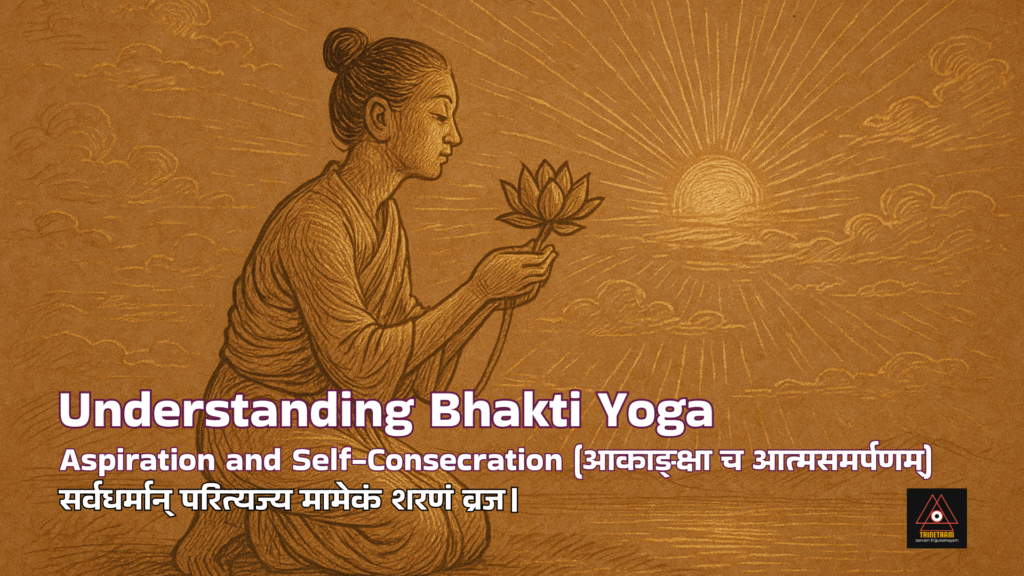
Every pilgrimage begins with yearning.
The seeker feels the pull of the Divine and decides to dedicate life to that call. Aspiration lights the flame; consecration protects it. In surrender, the heart whispers, “Thy will be done.”
As cited in Bhagavad Gītā 18.66 — सर्वधर्मान् परित्यज्य मामेकं शरणं व्रज। (Sarva-dharmān parityajya mām ekaṁ śaraṇaṁ vraja) Means “Abandon all duties and take refuge in Me alone; I shall liberate you”.
Insight: True surrender is not weakness; it is the courage to let the Infinite lead the finite.
2· Devotion (भक्ति)

Aspiration matures into steady devotion—a joyful discipline of love.
Here faith stabilizes; the devotee remembers the Divine amid daily duties. Prayer and song become as natural as breathing.
As cited in Bhagavad Gītā 9.34 — मन्मना भव मद्भक्तो मद्याजी मां नमस्कुरु। (Man-manā bhava mad-bhakto mad-yājī māṁ namaskuru) Means “Fix your mind on Me, be devoted to Me, worship Me, and bow to Me”.
Insight: Devotion is love made constant; its rhythm beats with every pulse.
3· Adoration and Worship (पूजा उपासना)
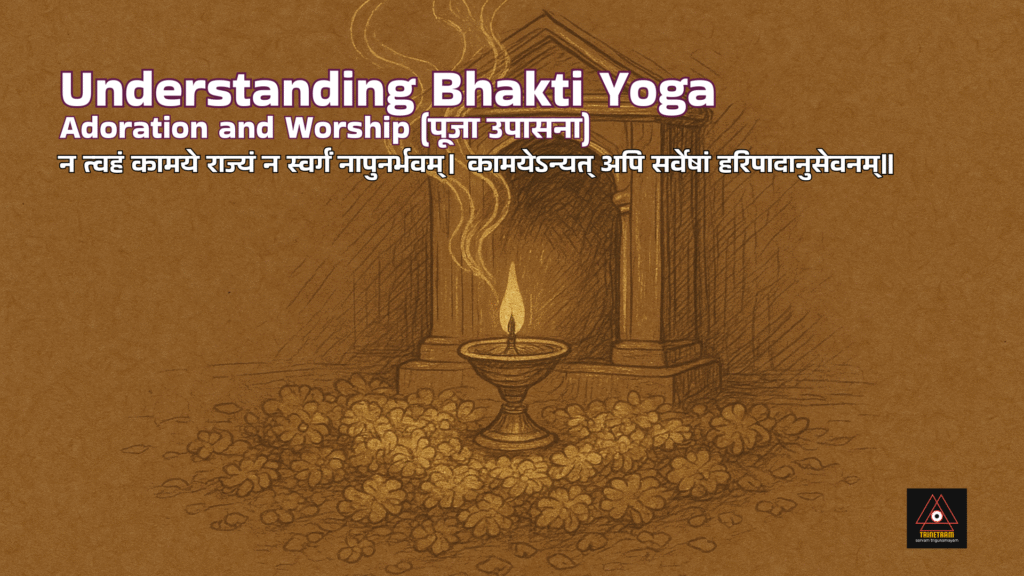
Love seeks expression through beauty.
Lighting a lamp, arranging flowers, chanting mantras—each gesture becomes dialogue with the Beloved. Worship transforms matter into meaning and time into eternity.
As cited in Śrīmad Bhāgavata Purāṇa – 7.10.6 — न त्वहं कामये राज्यं न स्वर्गं नापुनर्भवम्। कामयेऽन्यत् अपि सर्वेषां हरिपादानुसेवनम्॥ (Na tv ahaṁ kāmaye rājyaṁ na svargaṁ nāpunarbhavam, kāmaye ’nyat api sarveṣāṁ Hari-pādānusevanam) Means “I desire neither kingdom, nor heaven, nor liberation — I desire only loving service at the feet of Hari.”
Insight: The devotee offers not material things but selfless love and service, which pleases the Divine more than any possession.
4· Love (प्रेम)
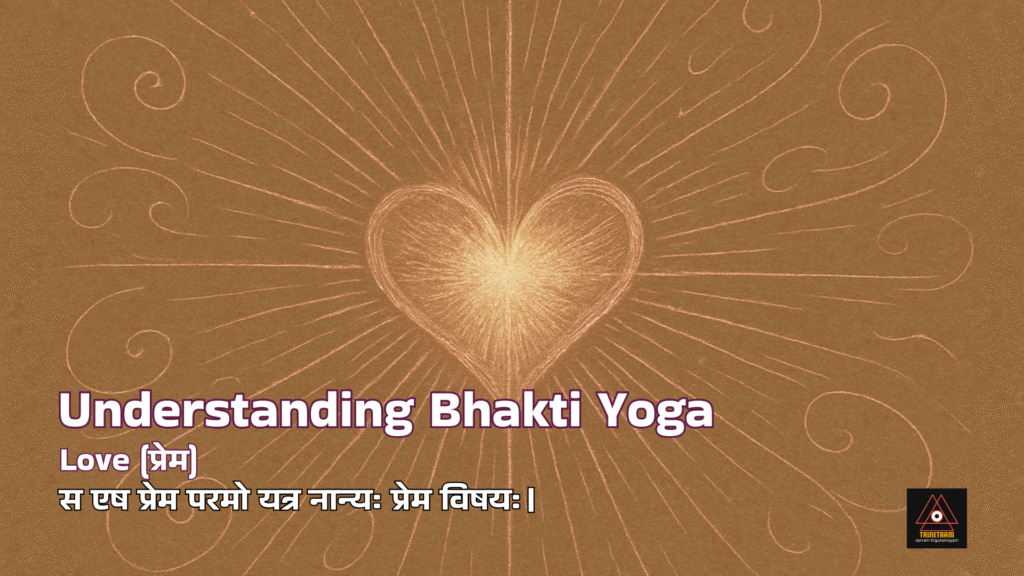
At this stage, love is no longer seeking.
It has no reason, no bargain; it simply is. The devotee loves God for God’s own sake, the way flame loves to burn.
As cited in Nārada Bhakti Sūtra 54 — स एष प्रेम परमो यत्र नान्यः प्रेम विषयः। (Sa eṣa prema paramo yatra nānyaḥ prema-viṣayaḥ) Means “That is supreme love where no other object remains but the Divine alone”.
Insight: Prema is pure awareness taking the form of tenderness; it sees the world through the eyes of the Beloved.
5· Possession by the Divine (आत्मसमर्पणस्य परिपूर्णता)
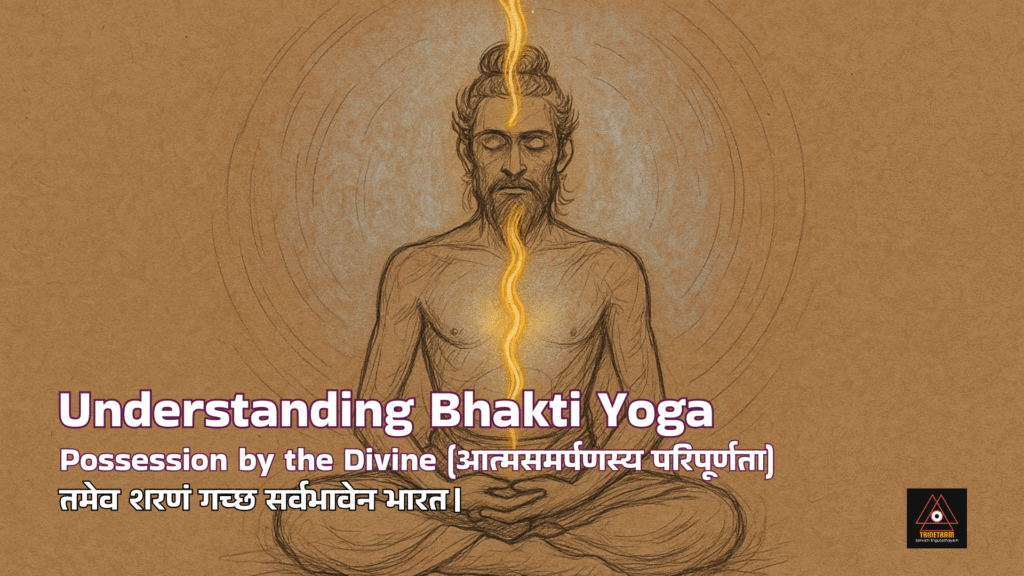
When love consumes ego, the Divine acts through the devotee.
Every word, deed, and thought becomes guided by an unseen intelligence. The person remains, yet is transparent like a window for divine light.
As cited in Bhagavad Gītā 18.62 — तमेव शरणं गच्छ सर्वभावेन भारत। (Tam eva śaraṇaṁ gaccha sarva-bhāvena bhārata) Means “Surrender to Him with your whole being; by His grace you shall find peace”.
Insight: The flute does not play itself; wind moves through it. So too the devotee becomes an instrument of Grace.
6· Joy of Divine Love and Beauty (माधुर्य भावः)
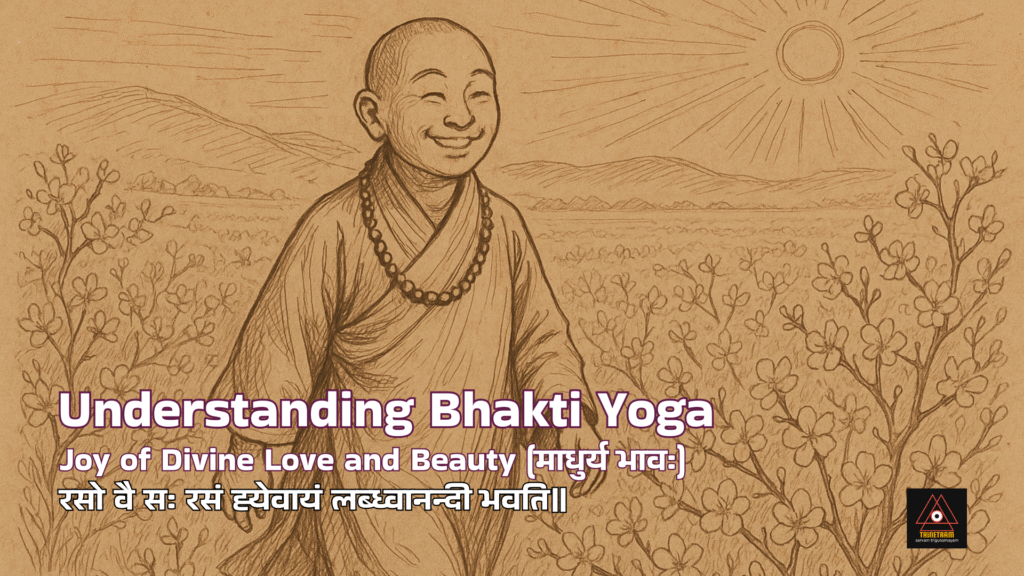
When the Divine pervades everything, existence appears as a dance of sweetness.
Every sight and sound glows with charm; every act overflows with gratitude. Life becomes divine play (Līlā).
As cited in Taittirīya Upaniṣad 2.7.1 — रसो वै सः रसं ह्येवायं लब्ध्वानन्दी भवति॥ (Raso vai saḥ, rasaṁ hy evāyaṁ labdhvānandī bhavati) Means “The Divine is Bliss itself; tasting that essence, one becomes joyful”.
Insight: Here joy no longer depends on events; it streams naturally from the heart’s union with the Beloved.
7· The Absolute Bliss of the Absolute (परमानन्दः)
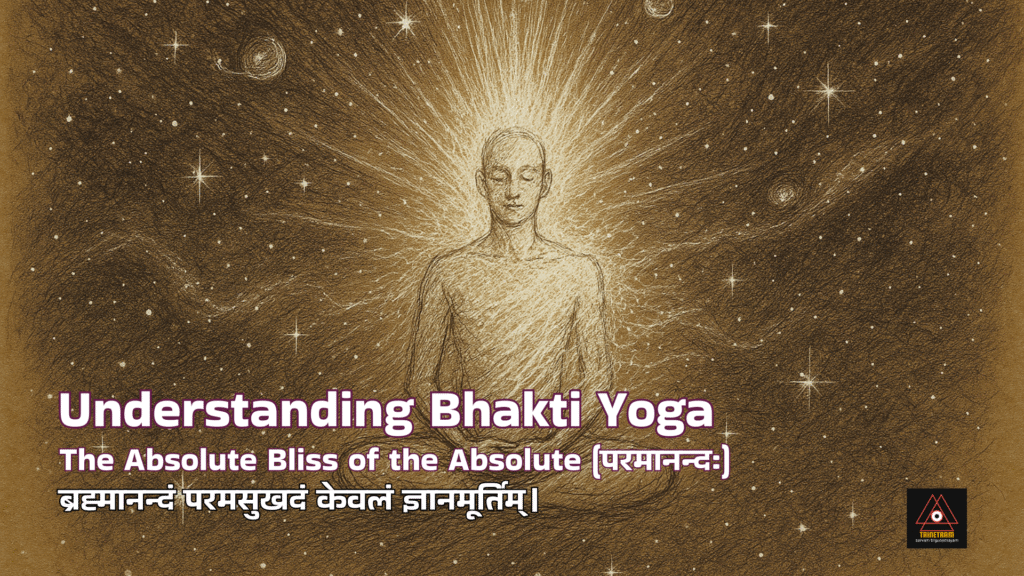
In the final stage, devotion dissolves into pure being.
There is no worshipper or worshipped—only blissful consciousness extending everywhere. This is Nirvana: stillness radiant with delight.
As cited in Guru Gītā — ब्रह्मानन्दं परमसुखदं केवलं ज्ञानमूर्तिम्। (Brahmānandaṁ parama-sukhadaṁ kevalaṁ jñāna-mūrtim) Means “The bliss of Brahman—supreme happiness, pure consciousness”.
Insight: This is not the end of love but its fulfillment; the ocean has found itself in every drop.
How to Practice Bhakti Yoga (भक्तियोगस्य साधनप्रकारः)
Bhakti is not ritual alone—it is the art of living with awareness of the Divine.
Each action, when offered with love, becomes yoga.
1· Nāma-Saṅkīrtana — Chanting the Divine Name
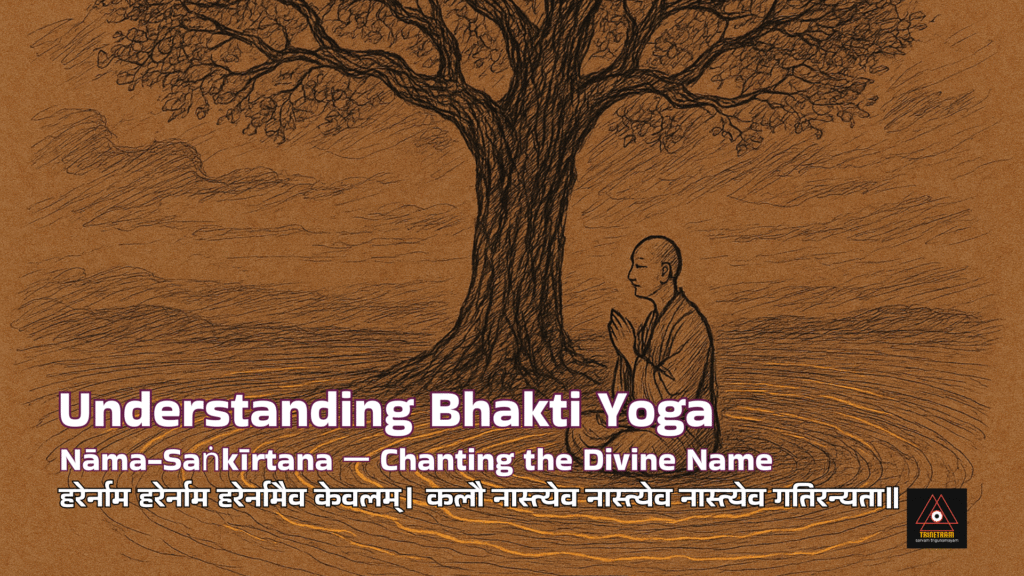
Sound is the bridge between heart and universe.
Chanting sacred names purifies emotion and aligns inner rhythm with cosmic vibration.
As cited in Bṛhan-Nāradiya Purāṇa 38.126 — हरेर्नाम हरेर्नाम हरेर्नामैव केवलम्। कलौ नास्त्येव नास्त्येव नास्त्येव गतिरन्यता॥ (Harer nāma harer nāma harer nāmaiva kevalam, kalau nāsty eva nāsty eva nāsty eva gatir anyathā) Means “In this age, there is no path higher than the repetition of the Divine Name”.
Practice: Begin each day with mantra recitation; feel sound rising from navel to crown, radiating peace.
2· Prārthanā and Dhyāna — Prayer and Meditation
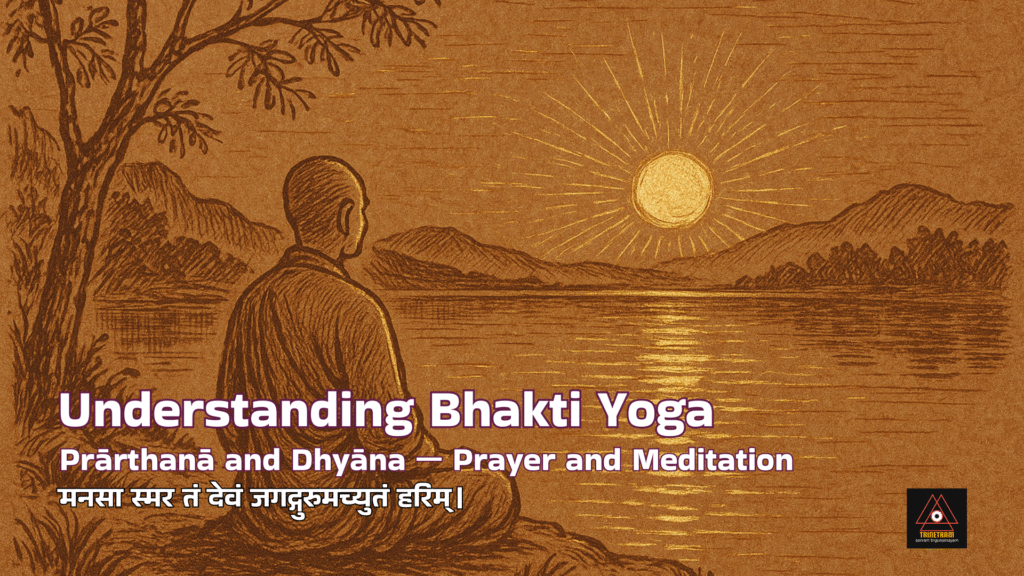
Prayer opens the heart; meditation deepens silence.
Through prayer we express longing and gratitude; through meditation we listen to God’s reply in stillness.
As cited in Viṣṇu Sahasranāma Phalaśruti — मनसा स्मर तं देवं जगद्गुरुमच्युतं हरिम्।(Manasā smara taṁ devaṁ jagad-gurum acyutaṁ harim) Means “Remember that Eternal Being, the Teacher of the Universe, Hari”.
Practice: At dawn or dusk, sit quietly; let breath slow and mind soften until awareness rests in presence.
3· Śravaṇa and Satsaṅga — Listening and Holy Company
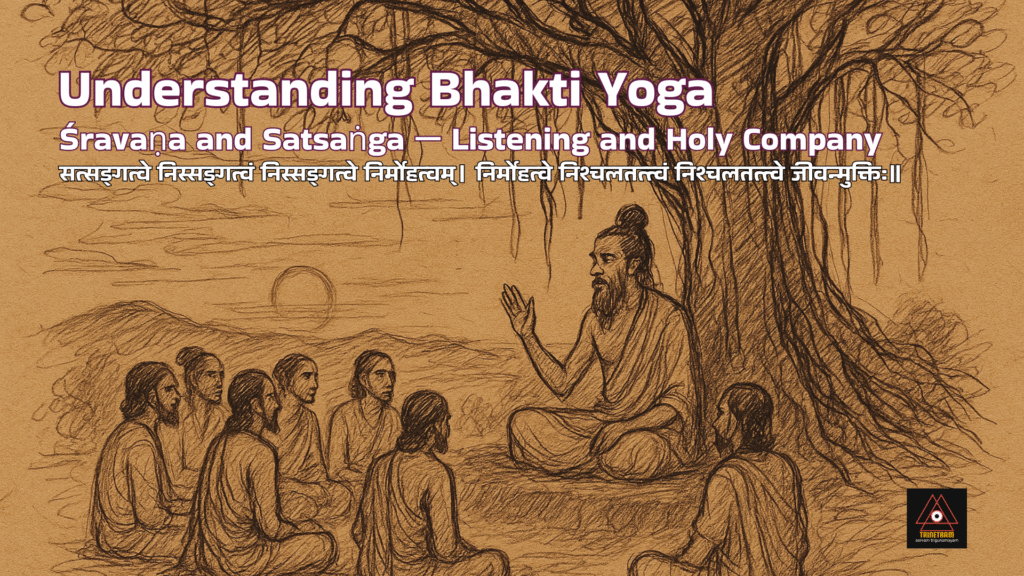
Seekers need companionship of the wise.
Association with pure minds keeps the flame of faith alive and protects it from the winds of doubt.
As cited in Vivekachūḍāmani 9 — सत्सङ्गत्वे निस्सङ्गत्वं निस्सङ्गत्वे निर्मोहत्वम्। निर्मोहत्वे निश्चलतत्त्वं निश्चलतत्त्वे जीवन्मुक्तिः॥ (Satsaṅgatve nissaṅgatvaṁ, nissaṅgatve nirmohatvam; nirmohatve niścalatattvaṁ, niścalatattve jīvanmuktiḥ) Means “From holy company comes detachment; from detachment, clarity; from clarity, steadiness; from steadiness, freedom”.
Practice: Read scriptures aloud, attend satsang, or discuss sacred texts with sincere friends.
4· Sevā — Selfless Service
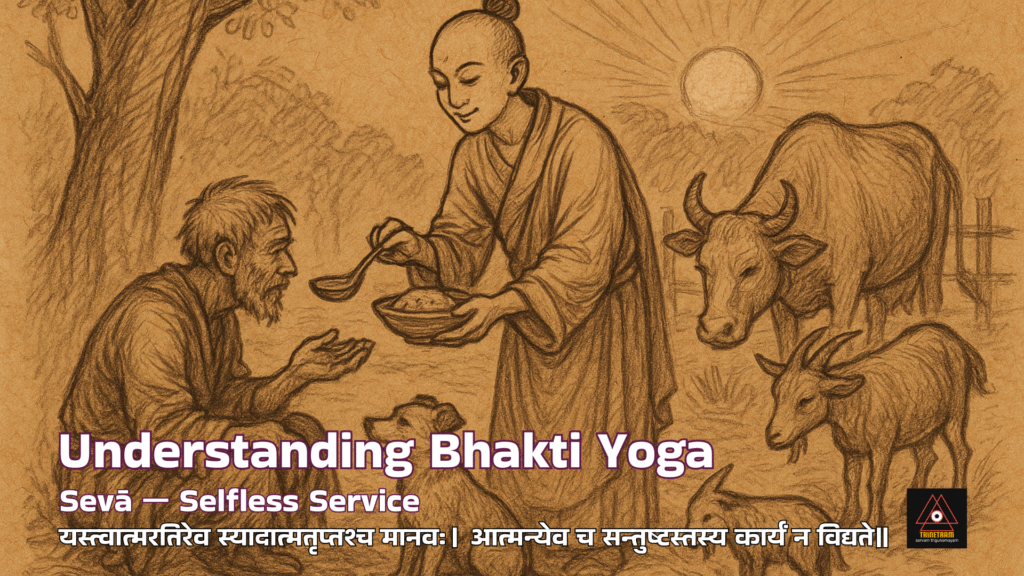
Service is love in action.
When one serves without thought of reward, one discovers joy that belongs to the soul.
Every creature becomes an opportunity to serve the Divine.
As cited in Bhagavad Gītā 3.17 — यस्त्वात्मरतिरेव स्यादात्मतृप्तश्च मानवः। आत्मन्येव च सन्तुष्टस्तस्य कार्यं न विद्यते॥(Yas tv ātma-ratir eva syād ātma-tṛptaś ca mānavaḥ, ātmany eva ca santuṣṭas tasya kāryaṁ na vidyate) Means “One who delights in the Self and serves from fullness has nothing left to seek”.
Practice: Offer your time to help, teach, or heal. Do it quietly, knowing God accepts the act.
5· Ārādhana — Daily Worship
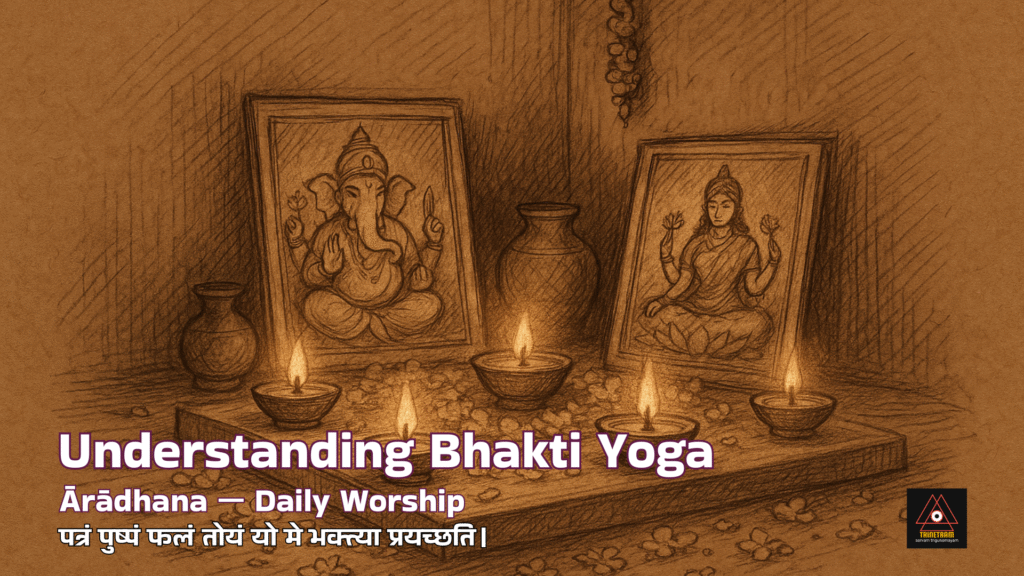
Worship anchors awareness in reverence.
Lighting a lamp or offering water trains the body to act with devotion and mindfulness.
Outer ritual nurtures inner stillness.
As cited in Bhagavad Gītā 9.26 — पत्रं पुष्पं फलं तोयं यो मे भक्त्या प्रयच्छति। (Patraṁ puṣpaṁ phalaṁ toyaṁ yo me bhaktyā prayacchati.) Means “Whoever offers Me a leaf, a flower, a fruit, or water with devotion—I accept that gift”.
Practice: Keep a small altar; before meals or sleep, bow inwardly and offer gratitude.
6· Manana and Samarpana — Reflection and Surrender
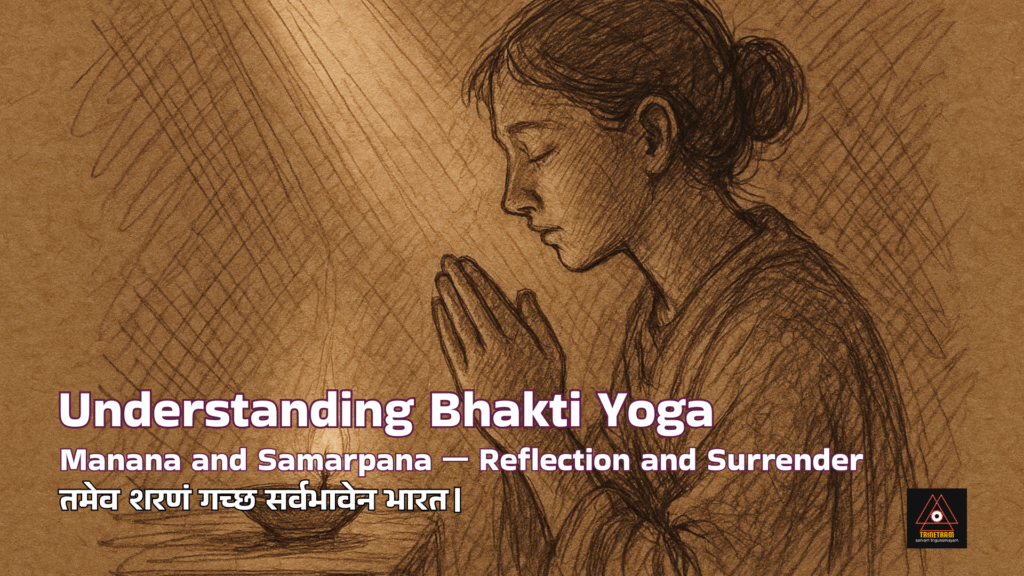
Each evening, look back gently on the day—actions, thoughts, words—and place them at God’s feet.
Reflection clarifies; surrender frees. The burden of doership melts into peace.
As cited in Bhagavad Gītā 18.62 — तमेव शरणं गच्छ सर्वभावेन भारत।(Tam eva śaraṇaṁ gaccha sarva-bhāvena Bhārata) Means “Take refuge in Him with all your heart; through His grace you will find peace”.
Practice: End the day with a short prayer: “Whatever I did today, O Lord, was Thine.”
7· Bhāva — Living in Constant Love
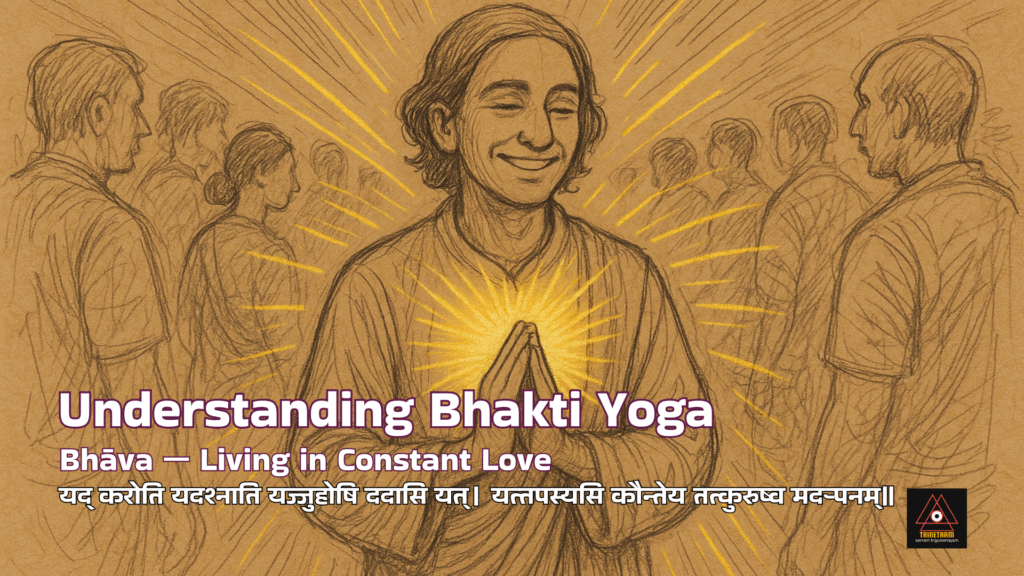
When love saturates consciousness, practice becomes presence.
Every heartbeat chants a mantra; every gesture is worship. Joy and sorrow are seen as divine play (Līlā).
As cited in Bhagavad Gītā 9.27 — यद् करोति यदश्नाति यज्जुहोषि ददासि यत्। यत्तपस्यसि कौन्तेय तत्कुरुष्व मदर्पनम्॥ (Yad karoti yad aśnāti yaj juhoṣi dadāsi yat, yat tapasyasi Kaunteya tat kuruṣva mad-arpaṇam) Means “Whatever you do, whatever you give or endure, do it as an offering to Me”.
Insight: Bhakti matures into a state where one no longer remembers to remember—because remembrance has become one’s nature.
Misconceptions and Myths (भक्तियोगस्य भ्रान्तयः)
Bhakti Yoga is often misunderstood as blind faith or emotional indulgence, yet it is one of the most refined sciences of consciousness.
Let us clear some deep misconceptions.
1. “Bhakti is only for the emotional or simple-minded.”
Many assume that only intellectuals pursue Jñāna and the sentimental pursue Bhakti.
But Bhakti is not mere emotion—it is the spiritualization of emotion. To love the Infinite consciously requires tremendous intelligence and inner maturity.
As cited in Bhāgavata Purāṇa 9.4.63 — अहं भक्तपराधीनो ह्यस्वतन्त्र इव द्विज। (Ahaṁ bhakta-parādhīno hy asvatantra iva dvija) Means “The Lord is bound by the love of His devotee and moves through that heart alone”.
2. “Bhakti means idol worship.”
The idol is not God but a doorway to God.
Form focuses the formless; worshipping an image with devotion trains the heart to perceive the invisible through the visible. When consciousness expands, the devotee sees the same Divine in all forms.
As cited in Rig Veda 1.164.46 — एकं सद्विप्रा बहुधा वदन्ति। (Ekaṁ sad viprā bahudhā vadanti) Means “Truth is one, sages call It by many names”.
3. “Bhakti excludes knowledge and action.”
True Bhakti unites them both—love guided by wisdom, expressed through service.
Jñāna without Bhakti is dry; Karma without Bhakti is egoic. Bhakti integrates them, making every act a conscious offering.
As cited in Bhagavad Gītā 9.27 — यत्करोषि यदश्नासि यज्जुहोषि ददासि यत्। यत्तपस्यसि कौन्तेय तत्कुरुष्व मदर्पणम्॥ (Yat karoṣi yad aśnāsi yaj juhoṣi dadāsi yat, yat tapasyasi Kaunteya tat kuruṣva mad-arpaṇam) Means “O son of Kunti (Arjuna), whatever you do, whatever you eat, whatever you offer in sacrifice, whatever you give, and whatever austerity you perform — do that as an offering unto Me.”
4. “Devotion is weakness or escapism.”
Surrender is the highest strength.
It requires the courage to give up control and the wisdom to trust the unseen hand of the Divine. Bhakti empowers, it does not enslave.
As cited in Bhagavad Gītā 18.55 — भक्त्या मामभिजानाति यावान्यश्चास्मि तत्त्वतः। (Bhaktyā mām abhijānāti yāvān yaś cāsmi tattvataḥ) Means “Through Bhakti, one discovers the ultimate freedom—the freedom from oneself”.
Conclusion
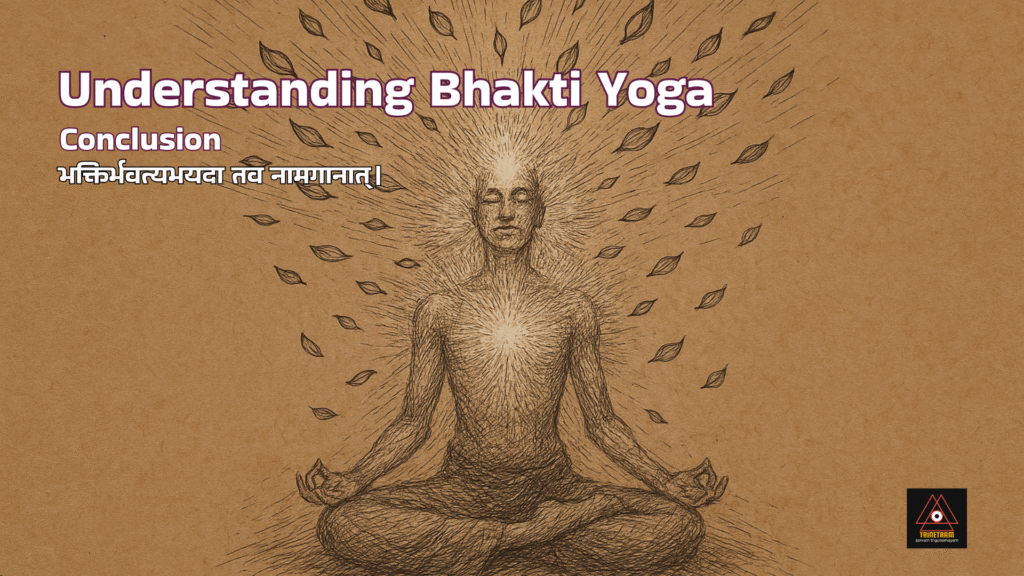
Bhakti Yoga is the music of existence—the song the soul sings to the Infinite.
It heals the body by harmonizing emotion; it refines the mind by surrender; it liberates the spirit by love. When love fills every thought, the devotee no longer sees God as separate—the whole world becomes the face of the Beloved.
Then all creation becomes a hymn, every being a temple, every breath a prayer.
This is the ultimate alignment to Nirvana—the still bliss where Love and Awareness are one.
As cited in Śrī Hanumat Stava 42 — भक्तिर्भवत्यभयदा तव नामगानात्। (Bhaktir bhavaty abhaya-dā tava nāma-gānāt) Means “Singing Thy name brings fearlessness and eternal peace.”
We will explore Karma Yoga – The Path of Selfless Action in our upcoming blog. Until then, stay tuned to trinetramyc.com! 🌈
We would love to hear your valuable thoughts and insights to help us deepen this exploration.
Thank you,
Team Trinetram 🙏

Leave a Reply